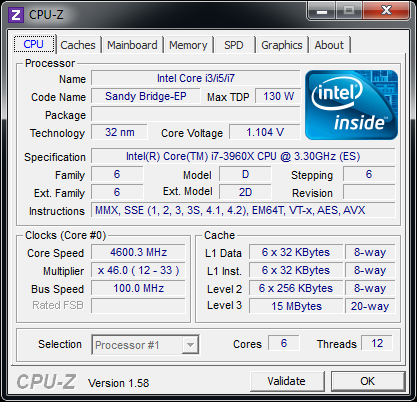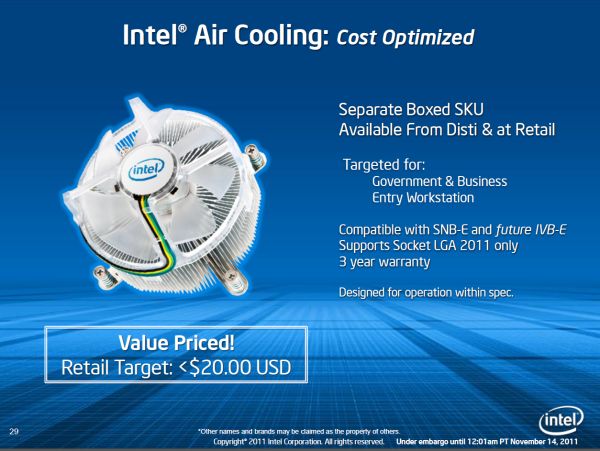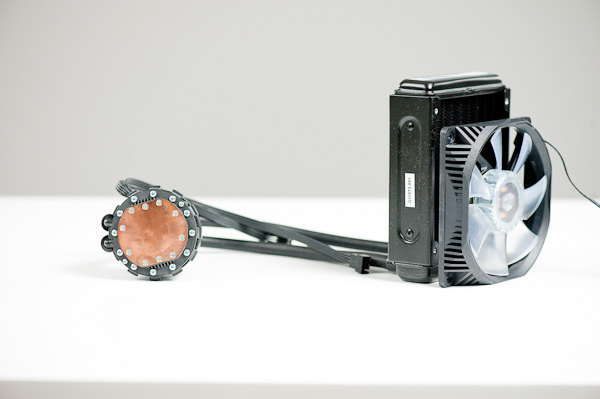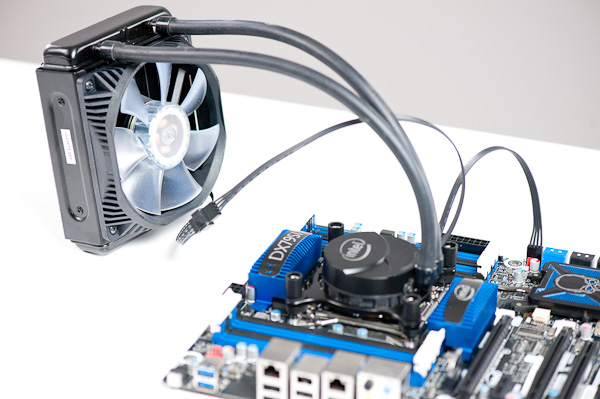Intel Core i7 3960X (Sandy Bridge E) Review: Keeping the High End Alive
by Anand Lal Shimpi on November 14, 2011 3:01 AM EST- Posted in
- CPUs
- Intel
- Core i7
- Sandy Bridge
- Sandy Bridge E
Overclocking
Sandy Bridge brought the motherboard's clock generator onto the 6-series chipset die. In doing so, Intel also locked its operation to 100MHz. While there was a bit of wiggle room, when combined with a locked processor, Intel effectively killed overclocking with most lower end Sandy Bridge chips.
For its more expensive CPUs, Intel offered either partially or fully unlocked (K-series) CPUs. The bus clock was still fixed at 100MHz, but you could overclock your processor by increasing its clock multiplier just like you could in the early days of overclocking.
With Sandy Bridge E, overclocking changes a bit. The clock generator is still mostly impervious to significant bus clock changes, however you're now able to send a multiple of its frequency to the CPU if you so desire. The options available are 100MHz, 125MHz, 166MHz and 250MHz.
Once again, wiggle room at any of these frequencies is limited so don't think we've moved back to the days of bus overclocking. You do get a little more flexibility, particularly with partially unlocked CPUs, but otherwise SNB-E overclocking is hardly any different from its predecessor.
Note that even if you select any of these options, the rest of the system still operates within spec. The multiplied bus clock is only fed to the CPU.

With a bit of effort I had no problems hitting 4.6GHz on my Core i7 3960X review sample. I had to increase core voltage from 1.104V to 1.44V, but the system was stable. While I could get into Windows at 4.8GHz and run a few benchmarks, the system wasn't completely stable.
No Cooler Included
None of the retail or OEM SNB-E parts include an Intel cooler in the bundle, a significant departure from previous CPUs. Presumably the cost of bundling a beefy cooler with these parts would've driven prices higher than Intel would've liked (remember you are getting a much larger die for roughly the same price as the outgoing Core i7 990X). Intel can also rationalize its decision against including any sort of cooler in the retail box by looking at the fact that many enthusiasts at this level opt for aftermarket cooling regardless.
Intel hasn't completely left SNB-E cooling up to 3rd party vendors however. There are two official Intel coolers available for use with SNB-E. The first is a < $20 heatsink that looks a lot like Intel's current coolers but with a couple of modifications (clear fan/shroud, retention screws instead of pegs). Intel states that this cooler is designed for operation within spec, meaning it could possibly limit overclocking attempts.

If you want an Intel branded overclocking solution, there's the RTS2011LC:

This is a closed loop liquid cooling solution similar to what AMD introduced alongside its Bulldozer CPU and similar to what many 3rd party cooling companies already offer. Intel expects its liquid cooling solution to be priced somewhere in the $85 - $100 range.
These closed loop liquid coolers are great primarily for getting away from the tower-of-metal heatsinks that have grown in popularity over the past several years. The radiator is a too small to compete with more traditional water cooling systems, but it can be a good gateway drug for the risk averse.











163 Comments
View All Comments
Valitri - Wednesday, November 16, 2011 - link
Good review as always.Turns out to be slightly less than I was expecting. The performance "jump" from an 1155 SB just isn't there for generic enthusiasts and gamers. Perhaps encoders, renderers, and mathmaticians will enjoy the performance but it doesn't do much for me. Makes me very happy I stepped to a 2500k and I look forward to Ivy Bridge early next year.
Gonemad - Wednesday, November 16, 2011 - link
If there are 16GB DIMMs, and this sucker has 8 DIMMs sockets... 128GB in a home system... hmmm. It makes SSDs all the less appealing. (Specially because you just blew lots of money in DIMM memory, but still...). Pop in a Ramdrive, wait 5 minutes to boot... don't wait anymore. I can see some specific usage that could benefit of this kind of storage subsystem speed. Even if it is a 'tiny' 64GB ramdrive.It may not entirely replace a small SSD, but you can do some neat tricks with that kind of RAM at home. I know only one module is many times more expensive than a SSD, but just the fact that you can do it is remarkable.
Too bad this chip costs a lot, and IT. IS. HUGE. The thing has the size of a cup-holder, or at least the socket. With that amount of die you could build 2 * i7- 2600k and with the amount of money you blow on one, you can still pay for 3 * i7s.
Oh yes, check for yourselves. That's your premium profit margin right there.
This sucker has 435mm2 while the Sandy Bridge 4c has 216mm2. Twice more!
This behemoth will nick your pockets in $999, when a i7-2600k cuts you $317.
Nearly 3 times more. More than 3 times in fact. It is almost pi() times more. Wait, it is pi times more expensive, up to the third decimal. Hmm. I bet you are paying for the lost wafer too. Or it is just a wild coincidence. It doesn't perform twice as better, only 50% better, in some benchies. And it is so big that you can almost call it a TILE, not a CHIP. I am betting that on the same die you build 3 * 2600k, you can build only 2 of these and lose the difference. It should squash the competition. It is a bomb.
Some chip.
Diminishing returns indeed.
Wolfpup - Wednesday, November 16, 2011 - link
"All of this growth in die area comes at the expense of one of Sandy Bridge's greatest assets: its integrated graphics core"Whaaaaat? Greatest assets? It's a waste of space. It should be used for more cache or another core or whatever on the quad version. I can't believe this site...Anandtech of all places...has ANYTHING positive to say about integrated graphics!~
noeldillabough - Wednesday, November 16, 2011 - link
For laptops the integrated graphics is AWESOME however on my gaming machine with top end graphics cards eating space for integrated graphics seems silly.jmelgaard - Thursday, November 17, 2011 - link
The fact that you still talk about X number of cores shows you haven't understood my posts.Your thinking: "How many cores can I make my game utilize"
My model: "How many small enough jobs of processing can I split my game up into"
Number of cores have no relevance in modern architectures, while in a Game engine you properly wan't to take control over the execution of those jobs, priority jobs etc.
The funny thing is, your BF3 already runs on 500+ cores when it comes to the rendering, lighting, polygon transformations and so on... All by chopping the big job of rendering a screen into little bits of work... just like i suggest you can do with the rest of a game, just like we do with so many other applications today.
"I doubt it. There's a reason why game engines are modified as they get older."
Almost every single corp only sees ahead to the next budget year...
seapeople - Saturday, November 19, 2011 - link
Of course it's inevitable you would resort to personal attacks and profanity in an argument you are losing.It's a different mindset... do you think graphics work is programmed by thinking "Ok, today's GPU's have 500 cores, so let's optimize our game to use exactly 500 threads..."
abhicherath - Sunday, November 20, 2011 - link
Why?Why are those 2 fused off....seriously for a 1000 buck CPU, you don't expect intel to hold stuff back....gosh, this is competition crap. If AMD's bulldozers were powerful as hell and outperformed the i7's i sure as hell expect that those 2 cores would be active....what's your opinion?
jmelgaard - Sunday, November 20, 2011 - link
"This doesn't involve a diatribe about number of cores in modern architectures."What what?... Do you even know what you are writing anymore?
What I am talking about is software architecture, which is highly relevant to the discussion.
Flerp - Sunday, November 20, 2011 - link
Even though there are very healthy gains in specific areas, I find the Sandy E to be a bit underwhelming, especially compared to how badly the X58 slaughtered the 775 platforms when it made its debut. I guess I'll be holding on to my X58 platform for another year or so and see what kind of improvements Ivy will bring.jmelgaard - Monday, November 21, 2011 - link
@rarsonThe whole reason I begin to talk about software architectures is because you are so hell-bend on sticking to your idea of "optimizing to a number of cores", I had to have you realize that you need to let go of that idea, your refusal to do so only makes me hope that you don't actually work with software development. No offence intended, because I would never be fit building a house either, it's not my field.
If you had ever gotten to understand that, the next discussion would be if it was beneficial to adopt this strategy within games, if it was viable and if it had a ROI that was worth pursuing if you could choose outside the bounds of this years budget, would it be an architecture that might cost us 2 to 3 times to pursue now, but saved us 20% development costs on our next games or engines for the next 10 years.
Of-course this could be a swing-and-miss if someone revolutionized how we look at our processors, much like they have done with GPU's, but as we have "barely" entered the multi-core-cpu-era, I don't expect this to happen within the next 10 years.
However that is all irrelevant because 10 years is not the time-frame, it is not even 5 or 3... the time-frame is a year at a time, and the cheapest solution in the time-frame of this years budget, that's the chosen one, that's the reason you are looking for, that is why they do it. And this is how almost, if not all, stock-based corporation operates. Why?... Because they have to satisfy stockholders... There is no other reason or rationalizations behind it.
DICE it self is not a stock-based company, but it is a fully owned by Electronic Arts, which is. And so EA's financial numbers is directly impacted by DICE as it counts towards EA's assets (not necessarily Revenue though).
With that, I am done with you, your best argument seems to be "They did it, so that must be the right thing to do"... When was anyone's choice ever evidence of it being the best one?